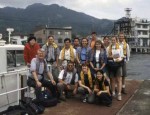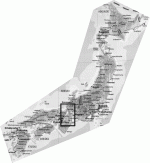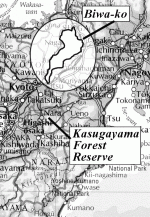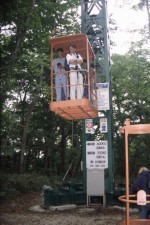In mid-June 1999 a group of 10 U.S. LTER graduate students and scientists toured research sites in the Otsu and Tomakomai areas of Japan, guided by Japanese LTER researchers. As representatives of the U.S. LTER Network, our objectives were to exchange information about the research conducted at Japanese and U.S. LTER sites, to lay the groundwork for future collaboration among our researchers, and ultimately to strengthen our interactions with our international colleagues.
The weeklong interaction with Japanese Long Term Ecological Researchers was as positive and optimistic as it was diverse. We found the consistently high caliber of research remarkable, as well as the generous accommodations. The diversity of ecological disciplines represented by our groups resulted in rewarding scientific and social dialogue with much promise for future collaboration.
Chris French (LTER Network Office) coordinated the visit which was financed by the National Science Foundation and the Japan Society for the Promotion of Science. The participating U.S. scientists were two faculty, John Magnuson (NTL) and Myron Mitchell (HBR), and eight students, Robert Daoust (PIE), Nicole Gerlanc (KNZ), Craig Layman (VCR), David Lewis (NTL), Stephanie Madson (CWT), and Anne Rhoads (HBR), Kristina Russell (VCR), and myself, Susan Sherrod (NWT).
A formal two-day conference held at the Tomakomai Experimental Forest was the academic core of the trip but our attention and activities were occupied daily - and nearly hourly - with local field trips to survey the research activities of our hosts. Aquatic and forest ecology encompassed most of our discussions and activities, and this report is organized by these broad disciplines.
Forest Ecology
Our first full day in Japan was spent in the region of the Kasugayama Forest Reserve, near the city of Nara. Dr. Mamoru Kanzaki (Kyoto University) and two of his graduate students, Kenta Tanaka and Toshiko Kawasaki guided the visit. The Kasugayama Forest Reserve is a natural monument and is protected not only by the Nara Provincial Government but, being a holy site, by the local Kasuga Shrine as well. Shika deer, considered sacred, roam freely in the area and introduce considerable grazing pressure to certain areas including the grass-covered mountain Wakakusayama.
Five major vegetation types are distinguishable in the research area, including late successional evergreen oak forest, secondary deciduous oak forest, Japanese cedar ("sugi"), and secondary forests of Pinus densiflora and Podocarpus nagi. Typhoons dominate the disturbance regime and create a mosaic of canopy gaps with average regeneration times of about 200 years. However, recent increases of Shika deer populations have severely impeded the revegetation of these canopy gaps.
Active research on ecosystems, plant community, and insect ecology has been underway since the 1970s at Kasugayama. A 14-ha research plot was established specifically for long-term monitoring in 1991. Several different universities, including Nara Women’s College, Kyoto University and Osaka City University, pool their research efforts to offset research costs.
The second major forest site we visited was the Tomakomai Experimental Forest (TEF) which is located on Hokkaido, the northernmost island of Japan. Established in 1904, this cool temperate forest (1200 mm avg. annual precipitation, 6.4 C avg. annual temp) also supports some culTIvation and grazing activities. Periodic eruptions from nearby Mt. Tarumae have produced the bulk of TEF’s volcanic soils, which support both non-native (25%) and young secondary forest regenerating after typhoon damage (75%). Japan’s Ministry of Education, Science, Sports, and Culture, in support of studying and preserving biodiversity, funds the bulk of TEF research.
Research projects at TEF focus on:
- Stream hydrology and biogeochemistry
- Forest-stream interactions
- Species composition and productivity
- Forest canopy structure, functions, and atmospheric interactions
- The impacts of herbivores on nutrient availability, plant C allocation, and reproductive capacity
Drs. Tsutom Hiura, Masashi Murakami, and Shigeru Nakano led our field excursions, which included visits to a number of specialized research structures. One was the canopy gondola, a 25m tall crane with a 40m arm from which researchers are suspended in a cage and measure gas fluxes and observe birds and insects. Plans are underway to build a similar structure at 80m tall and with a 90m arm. Nearby is the "jungle gym," a complex of scaffolding rising about 15m high, used for measuring canopy dynamics and bird-insect-plant interactions.
Exclosures are commonly used at TEF. Of several that we observed, the most expansive was the 1.2-km stream canopy exclosure, constructed in April 1999, to elucidate the reciprocation between food webs of the forest and stream (S. Nakano, PI). The netting used is 1-mm mesh, small enough to prevent passage of birds or insects. Just two months into the experiment, Nakano and colleagues were discerning many forest-stream interactions; for example, populations of the insectivorous flycatcher have emigrated from the exclosure area. In addition, fish that are dependent on terrestrial insects falling from overhanging trees have also vacated the 1.2-km stretch. Energy and nutrient fluxes between the forest and stream will also be studied with the use of this stream canopy exclosure. TEF researchers also use exclosures in the forest canopy (15 m2 exclosures) to evaluate the role of birds in the terrestrial food web (M. Murakami, PI), and around individual trees growing close to waterways to determine how particular tree species contribute to forest-stream interactions (M. Murakami, PI).
The research facilities at TEF are comfortable and include laboratories, a 38-bed dormitory, and a museum and other archives. Field equipment includes a 30-m tower with three observation arms, an artificial stream, a 14-m canopy ecophysiology analysis tower, and a CO2 flux monitoring station.
Aquatic Ecology
Long-term research of aquatic systems is also a major component of ecological activities in Japan. On this visit, our reviews of aquatic research emphasized two lakes, Lake Biwa (Biwa-ko) and Lake Toya (Toya-ko).
On the main island of Honshu, the large surface area of Biwa-ko (670 km2) makes it the largest lake in Japan and indispensible for wetland habitat (1145 ha) and drinking water for the 14 million residents of Osaka, Kyoto, and Kobe. Since the 1960s water quality intensive industrial and agricultural development has severely degraded water quality.
These issues have received considerable public attention, including implementation of the 1979 National Anti-Eutrophication Ordinance and other prefectural measures. Despite these policy implementations, however, the water quality of Biwa-ko has not clearly improved and eutrophication remains a threat. Ecological research in the watershed hence focuses on returning the lake and its environment to sustainable levels of recreation, fishing, agriculture, and other land and lake uses. This research is well funded by the prefectural government.
The Lake Biwa Research Institute (LBRI), sponsored by the prefecture, classifies its research into four major categories. Project-based research is largely interdisciplinary and supports three-to-five-year programs such as assessing the effects of forest clearing in the Biwa-ko watershed, the effectiveness of controls of non-point source pollution, and trends of dissolved organic matter.
Priority-subject research is designed to provide information on a very short time scale, such as for the development of a management policy or to lay the framework for a project-based research project. Continuing basic research is carried out by each of the LBRI faculty members within their field of specialty. Lastly, the lake shuttle project is an effort to improve the design and construction of underwater research vessels. In addition to these broad areas, monitoring remains active as does research on watershed management and environmental policy.
Dr. Tetsuya Narita of the Ecological Research Center (Kyoto University) led our excursion onto Biwa-ko. We sailed from the eutrophic south basin of the lake to a site in the mesotrophic north basin with a depth of about 50m, where several graduate students directed the collection of water samples. Measurements included transmissivity, photosynthetically active radiation, conductivity, dissolved O2, temperature, salinity, pressure, chlorophyll, and pH, and zooplankton.
We spent one morning at the extraordinary Lake Biwa Museum, a collection of artifacts and information emphasizing the relationship between humans and their use of the lake. Thirty scientists work at the museum, which offers remarkable descriptions of the lake’s geological history, its history of human settlements 10,000 years ago, the contemporary relationship of the lake with its (human and non-human) users, and the largest freshwater aquarium in Japan. The museum also has outdoor exhibits of forests in different geological time periods, farming fields, streams, and ponds. The Lake Biwa Museum is frequented by large numbers of people of all ages and origins and is surely an asset to the public outreach efforts of the nation’s scientists.
The second major lake that we visited was Toya-ko, a 70-km2 caldera lake located in the Shikotsu-Toya National Park in Hokkaido. The water of Toya-ko was contaminated in 1939 with the by-products of local sulfur mining, which depleted native populations of fish. Recent applications of lime and calcium carbonate have raised the pH from 5 to neutral, and the water is now used to generate hydroelectric power and for public consumption.
Established in 1936, the Toya Lake Station for Environmental Biology (Hokkaido University) historically researched "the Practical Exercise of Fish Culture and Environmental Biology," but currently emphasizes
- Wise use, including sustainable fisheries production
- Imprinting and homing mechanisms of kokanee salmon to the maternal river
- The reintroduction of sockeye salmon to Toya-ko to stable levels by 2001
Dr. Hiroshi Ueda, who showed us the facilities of the Station, including a hatchery house, fishponds, aquaria used for rearing kokanee and masu salmon, and a laboratory.
The Conference
On June 16th and 17th at TEF, several dozen researchers attended the International Young Researchers’ Workshop on Long-Term Ecological Research, organized by the Center for Ecological Research (Kyoto University) and TEF. Researchers discussed their respective LTER sites, as well as individual research. M. Miyahara of the NSF’s Tokyo office emphasized that Japanese researchers are eager to host scientists from other countries, including graduate students and post-graduate scientists. A variety of arrangements are possible with Japanese hosts. (See http://www.twics.com/~nsftokyo/home.html for details.)
We would be remiss if we did not mention the exceptional hospitality of our Japanese hosts. They paid meticulous attention to every detail of the days that we spent as their guests, including transportation, conference preparation, social events, and last but far from least important, beautifully prepared, elaborate, and delicious meals. Adequate reciprocation of their hospitality will surely be a challenge and a pleasure.

 Enlarge this image
Enlarge this image


